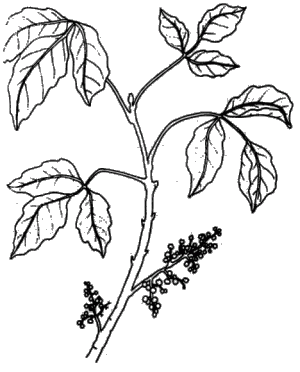Western Poison Oak


Synonyms: Pacific Poison Oak (en)
Other scientific names:
Occurrence: West coast of North America from British Columbia to Mexico in wooded slopes and thickets.
Description: Crawling shrub up to 3 m heigh or climbing up to 40 m. See Eastern Poison Oak.
Effects: See Toxicodendron species in general.
Measures: See Toxicodendron species in general.
Reference: U.S. Department of Health; Benezra; Roth; Peterson
Eastern Poison Oak


Occurrence: North America, particularly in the south-east of the USA in dry woodlands.
Description: Up to 1 m high shrub with threefold leaves. Single leaflets 3 to 7 cm long, lobed, slightly hairy underneath and brighter than on the top side. Flowering from May to June. Fruits hanging. See Poison Ivy.
Effects: See Toxicodendron species in general.
Measures: See Toxicodendron species in general.
Reference: U.S. Department of Health; Benezra; Roth; Peterson
Poison Ivy


Synonyms: Eastern Poison Ivy (en), Giftefeu (de)
Other scientific names:
Occurrence: Throughout North America, particularly in the eastern and central parts of the USA. Frequently found in forests and on fields, in rocky canyons and on river banks. At altitudes below 1300 m.
Description: Crawling shrub up to 2 m heigh, sometimes climbing higher. Leaves greenish, sometimes shiny, long-stalked, 10 to 35 cm long and threefold. Middle leave on a longer stalk. Young leaves orange to brown with yellowish veins. Flowers in June, yellowish green, 5 mm. Fruits are hard berries in the shape of a peeled Orange, 5 to 7 mm in diameter, greenish-white or yellowish, from August to March. Young parts of the plant slightly hairy. The plant contains a latex which gets dark in a few minutes when exposed to air.
Effects: See Toxicodendron species in general.
Measures: See Toxicodendron species in general.
Reference: U.S. Department of Health; Benezra; Roth; Peterson
Japanese Laquer Tree


Synonyms: Varnish Tree (en), Lacksumach (de), Urushi (jp)
Other scientific names:
Occurrence: Native of Japan, Central and western China. Also cultivated in other regions for the production of Japanese lacquer.
Description: 15 to 20 m tall tree with 7- to 13-fold leaves. Single leaflets are 10 to 20 cm long and 3 to 7 cm wide. Berries are straw-coloured, 10 mm in diameter. Appearance like Toxicodendron vernix. The milky latex turns black in a few minutes when exposed to air.
Effects: The sap acts skin-irritating chemically and is allergizing. The dried lacquer is skin-irritating only for very few people.
Measures: See Toxicodendron species in general.
Poison Sumac


Synonyms: Giftsumach (de)
Other scientific names:
Occurrence: North America, particularly in the east in swampy areas.
Description: Shrub or small tree up to 3 m, rarely up to 7 m. Twigs orange to brown, later becoming grey. Leaves up to 40 cm long and 7- to 13-fold. Single leaflets shorter than 10 cm. Inflorescences with fluffy hairs and longer than 10 cm. Berries white, hard, sperical, smooth, 5 mm in diameter, yellowish or grey in hanging clusters. (Harmless Sumac species, on the contrary, have red fruits).
Effects: See Toxicodendron species in general.

